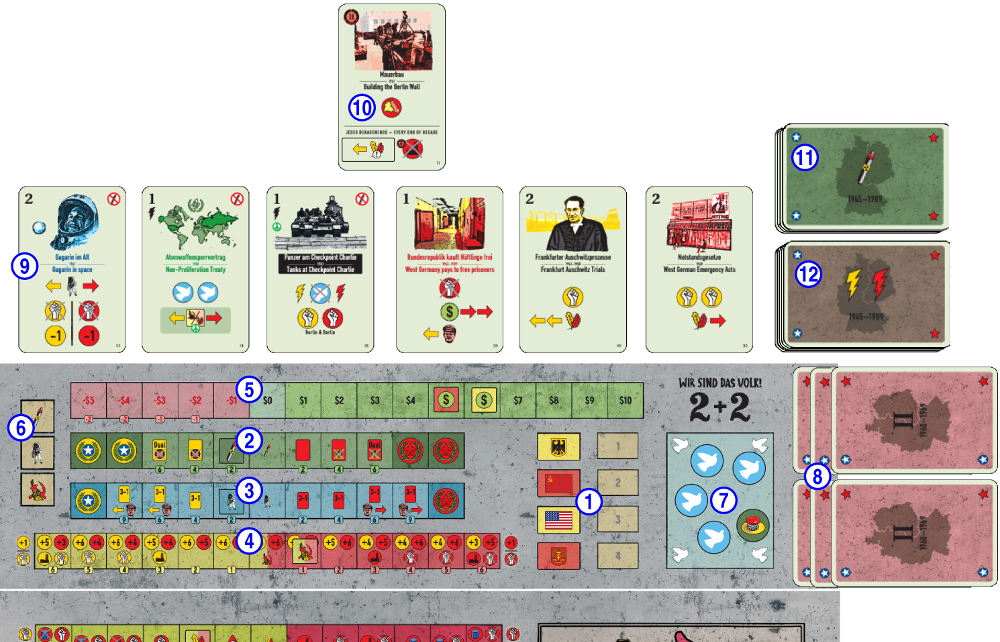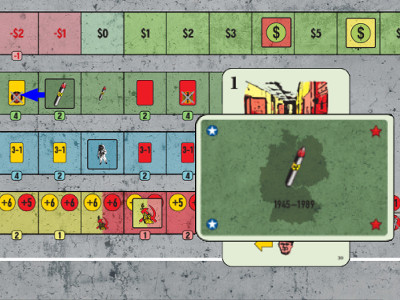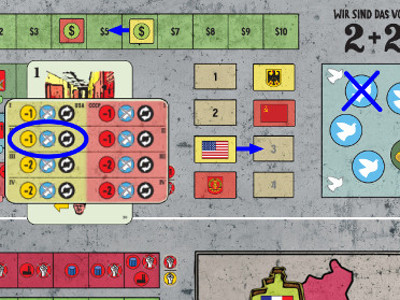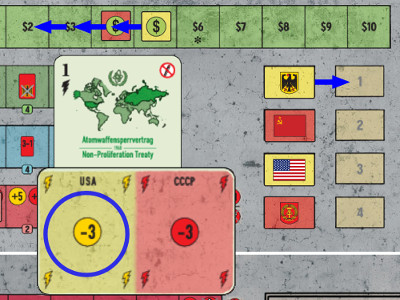The game board
When you know Wir sind das Volk (WSDV) learning 2+2 is not difficult.
It is useful to take a look at the game board first. Below you find a situation at the beginning of decade II .
(Note: As in WSDV, every player has 2 hand cards each.)
|
 |
|
 |
Turn order changes from decade to decade and is marked here. |
|
 |
Arms race. The superpowers are engaged in the arms race for which this track is needed.
|
|
 |
Space race. Likewise the space race is tracked here. |
|
 |
Dominance. Furthermore, the superpower fight for global dominance on this track.
|
|
 |
Treasury. The superpowers have to pay many actions with money. Their treasury is tracked here. |
|
 |
The end of decade of the base game is expanded by resolving the arms race, space race and dominance track. |
|
 |
World peace is safe as long as there are peace doves in this pool. However, when only the red button is left, the world is facing nuclear apocalypse.
|
|
 |
Sub-decade tracker.
A decade consists of 3 sub-decade. Here, the 2+2 cards for sub-decades B and C are laid out.
|
|
 |
The open display is formed by 6 cards and the special card. 2+2
introduces Blue, Green and Black cards. |
|
 |
The special card is marked with a special tile which transfroms a
prestige arrow into a prestige arrow with an exclamation mark.
|
|
 |
Arms race cards.
There are 10 arms race cards which should be stacked nearby the board. |
|
 |
Conflict cards. The 10 conflict cards are stacked
nearby as well.
|
|
How to play 2+2 ...
An easy way to introduce you to 2+2 is by playing one sub-decade. As mentioned above, at the
beginning of the first sub-decade, the turn order is determined (by comparing the prestige and dominance tracks). In this example
the turn order is:
1.) West Germany (referred to as West, as in the base game)
2.) Soviet Union
3.) USA
4.) East
Note: In this example, players will not play any of their hand cards.
|
|
|

|
|

|
1. West has the first action.
It picks the card "West German Emergency Acts" and uses it for building up its economy. The base game rules are in unchanged for that.
With the 2 build points, West places 2 new factories in its territory. After that, West shifts its player marker to the right, thus indicating
that its turn is done.
Excursus: West and East can perform the same actions as in the base game. And the superpowers can perform these actions as well. (They are building up "their" part of Germany, as if they were West or East, respectively.) In addition to these base game actions, superpowers can perform an arms race action and a take credit action.
|
|
2. The Soviet Union is next. It goes for "Gagarin in space", a Blue card, and triggers the event.
(A Blue card event can be triggered by any player.) Blue card events are symmetrical, this means that the Soviet Union can ignore all yellow arrows and icons. The event results in: 1.) Shifting the space race marker by 1 to the right. 2.) Removing 1 East unrest cube chosen by the Soviet Union (not depicted). 3.) Paying $1 by moving the Soviet treasury marker by 1 to the left.
Finishing its Actin, the Soviets move their player marker to the right (not depicted).
|
|

|
|

|
3a. Now it's the US turn. They decide for an arms race action. Only superpowers can perform this new action type. They can use every card, which has no bans-on-arms-race icon in the upper right corner. ("Gagarin in space" for instance has such an icon.) — The result is: The USA move the arms race marker by 1 in their favour. Furthermore they have to pick the top arms race card ...
(Note: Whenever you move the arms race marker in your favour, you have to pick and execute the top arms race card.)
|
|
... and execute it. The yellow part applies to the USA. The second line is used (because it is decade II).
The three icons mean: 1.) The USA have to pay $1 from their treasury. 2.) Remove 1 peace dove from the world peace pool. 3.)
Reshuffle all 10 arms race card and form a new draw deck. — After executing these effects, the US turn is over. The US player marker is shifted to the right.
Notes: a.) Only two of the ten arms race cards show the remove-peace-dove icon.
2.) At the moment, removing a peace dove is not a problem, since there are plenty left. However, when all peace doves are gone, then a player has to press the red button, thus triggering nuclear war. The game would then end immediately.
|
|

|
|

|
4. Next, East makes its action. It decides to build up
its economy. The chosen card has a value of 2. East places 2 new factories. — East finishes its turn by moving its player marker to the right. After that all player markers go back to their initial positions.
|
|
5. West's turn again. It chooses the card "Non-Proliferation Treaty". West could trigger that Green card event. (Green card events can be triggered by any player.)
However, it opts for an LS-action. As in the base game, it may place up to 3 LS octogons. After placing these, the black lightning below the card value has to be executed. This lightning means: The superpower of the active side (here, the USA) has to pick 1 conflict card...
|
|

|
|

|
... and has to execute it.
The yellow part applies to the USA: $3 are deducted from the US treasury. — Doing this ends West's turn; West's player marker is shifted to the right.
|
|
6. When there is only 1 normal card left in the open display, the sub-decade ends! The event of this last card is then triggered automatically...
|
|

|
|

|
... by executing its icons from top left to bottom right (as reading). So, the first icon to execute is the yellow lightning: This results in a conflict card affecting the USA. The revealed conflict card result in a shift of the dominance marker by 2 in Soviet favour. The next icon removes one peace dove (not depicted). Then...
|
|
... the red lightning is resolved: The Soviets have to pick a conflict card. The red part applies to them: The Soviet Union has to pay $2 from its treasury and the Western Currency marker is moved by 1 to the left. The last two icons of the event are 2 unrest icons titled "Berlin & Berlin": Both parts of the city receive one unrest cube each. Now the first sub-decade is completely played through.
(The next sub-decade will start with 6 new cards in the open display; the Soviet union will play first.)
|
|
End of decade and victory
|

|
|

|
End of decade. The decade ends after three sub-decades.
Before playing the 10 base game end of decade phases, the 3 new tracks are resolved:
1.) Arms race: Besides other advantages, an immediate victory is possible when the marker is in a space with a laurel crown.
2.) Space race: A superpower can gain a hand cards advantage and win directly.
3.) Dominance: This track yields income to the superpowers. There are also some bonus icons similar to the icons on the prestige track.
|
|
Victory.
The spaces on the 3 new tracks include victory points (VPs). (It is the number in the small rounded box.) In the above picture, the USA is at a VP level of 4 on the arms race track, while the Soviet Union is on a VP level of 3 on the dominance track. (The space race is a tie, no VPs for anyone.) Game victory is decided following this procedure:
•
If West wins according to the base game victory conditions, game victory is awarded to:
▸ the USA, if they have more VPs than the Soviet Union;
▸ West Germany otherwise.
•
If East wins according to the base game victory conditions, game victory is awarded to:
▸ the Soviet Union, if it has more VPs than the USA;
▸ to East Germany otherwise.
It should be mentioned that victory is also possible by arms race, space race, or in case of a nuclear ware; please find the details in the rules booklet.
|